|
Governor Shigefumi Matsuzawa stressed the need to provide a separate smoking
room in public places.
Kanagawa Prefecture officially approved a waiter and waitress to work at
a restaurant with full of toxic
tobacco-smoke.
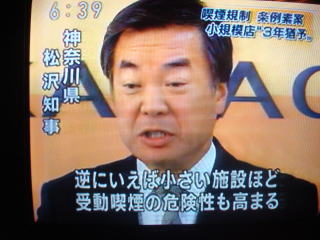
Governor Matuzawa pointed out that the risk of side-smoke is higher in
a small food facility.
Kanagawa's plan for smoking ban in public places
Kanagawa Gov. Shigefumi Matsuzawa said on April 15 the prefecture has compiled a basic plan for an
ordinance to ban smoking in hotels, restaurants and other public places
to prevent passive smoking. In
2003, the centralgovernment introduced a health promotion law that encourages
steps to prevent
secondhand smoke in public places. Likely to be subject to the total smoking ban are schools, hospitals,
department stores, government buildings, restaurants and bars, as well
as pachinko parlors. The prefecture
may consider requiring the owners of such facilities to remove ashtrays
and warn smokers. It will also
consider establishing penalties for violators, including people who smoke
at public indoor facilities.
Source: April 16, 2008 Japan Times
Tobacco firm recommends Creating Smoking Rooms.
The tobacco industries are trying to impede the introduction of smoke-free
policies. They have done this by,
for example, casting doubts on the adverse health effects associated with
exposure to secondhand smoke.
Further, cigarette firms will often try to promote alternatives to total
smoking bans, suggesting environments
that allow both smoking and smoke-free areas or encouraging other solutions
to smoking, such as ventilation,
rather than outright bans.
Dr. Maria Leon, International Agency for Research on Cancer (IARC), Lyon,
France, July, 2008
The Kanagawa Local ordinance for smoking restriction
The Kanagawa Prefectural Government has decided to exempt pachinko parlors
from the proposed smoking
ban in the prefecture, the governor announced in January 2009.After receiving
strong opposition from the
private sector amid tough economic conditions, Gov. Shigefumi Matsuzawa apparently has given up on his
initial proposal to adopt a total smoking ban in the prefecture. This is
the third time for the governor to make
revisions to his outright smoking ban proposal since its introduction April
2008. However, under increased
criticism from private industries and the Prefectural assembly, the governor accepted the idea of including
an installation of separate smoking areas, in September 2008. In December,
the government decided to
give smaller restaurants a three-year extension to meet the smoking ban
requirements. Under the new
amendment, facilities such as pachinko parlors, which tend to have a high percentage of smokers as
customers, are excluded from the regulation. Additionally, although restaurants fall under the proposed
ordinance and must adopt a total or partial smoking ban, restaurants of
100 square meters or smaller, which
account for 70 percent of restaurants in the prefecture, are also exempted
from the regulation.
Source: The Mainichi Daily News January 14, 2009
Requirements for a separate smoking room
In a restaurant bar, a separate smoking room shall be contiguous to, i.e.
next to the restaurant bar area and
the entrance to such room cannot open into any restaurant dining areas.
No food or beverage service is
permitted in a designated smoking room at any time.
No employee of a bar or a restaurant bar with a smoking room may enter
the smoking room
until at least 15 minutes after all persons, who are smoking to have left
the room and the room is no longer
being used for smoking. If bar owner or operator with an approved room
for smoking is found in violation
of this rule on two or more occasions, the Commissioner will revoke your right to maintain a separate smoking
room in the bar: This document was expired in January 2006.
Source: Department of Health and Mental Hygiene, The City of New York
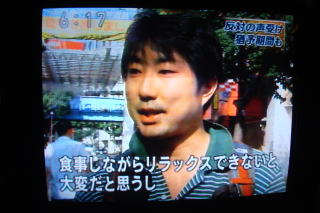
This man said it is important to relax in a restaurant while eating by
smoking.
The Kanagawa Local ordinance was watered down. Bars, restaurants and other
facilities now have the go-ahead to create separate smoking and non-smoking
areas.
When Kanagawa Prefecture first announced the ordinance bill last year,
it sought to impose all-out ban
on smoking in public places. However, both the tobacco industry and restaurants
put up fierce resistance.
As a result, the ordinance was watered down. Bars, restaurants and other
facilities now have the go-ahead
to create separate smoking and non-smoking areas.
Tobacco smoke damages the health of not only the smokers, but also those
nearby. It can cause diseases
like lung cancer and heart problems. The damage to children is especially
serious, as it could cause sudden
infant death syndrome and development disorders, so much so that smoking
is now called a silent form of
child abuse. According to a National Cancer Center estimate, some 20,000
to 30,000 people nationwide die
from illnesses related to involuntary smoking.
The World Health Organization's Framework Convention on Tobacco Control
urges the ratified countries,
including Japan, to ban smoking in public indoor spaces to prevent health
hazards by involuntary smoking,
and urges countries to come up with the necessary legislation. The WHO
says second-hand smoking is
hazardous, even in small amounts, and cannot be prevented by merely separating smoking and non
smoking areas.Creating smoking rooms, or installing air-cleaning devices,
are expensive but not effective.
Reference: The Asahi Shimbun, March 30, 2009
The WHO Framework Convention on Tobacco Control
The WHO Framework Convention on Tobacco Control (WHO FCTC) is the first
treaty negotiated under the
auspices of the World Health Organization. It was adopted by the World
Health Assembly on 21 May 2003
and entered into force on 27 February 2005. It has since become one of the most widely embraced treaties
in UN history and, as of today, has already168 Parties.
The WHO FCTC was developed in response to the globalization of the tobacco
epidemic and is an evidence
-based treaty that reaffirms the right of all people to the highest standard
of health. The Convention
represents a milestone for the promotion of public health and provides
new legal dimensions for inter-
national health cooperation.
Source: Convention Secretariat WHO Framework Convention on Tobacco Control
 Kanagawa Pref. New Anti-smoke Law, which may have an irrevocable Kanagawa Pref. New Anti-smoke Law, which may have an irrevocable
injurious effect on the future indoor clean-air act in Japan.
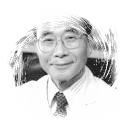
Kanagawa Pref.Gov.Matsuzawa, at the beginning, stated that the prefecture
had compiled a basic plan
for an ordinance to ban smoking in hotels, restaurants and other public
places to prevent passive smoking.
It would be the first such as local ordinance in Japan.
In 2003, the central government introduced a health promotion law that
encourages steps to prevent
secondhand smoke in public places. Kanagawa plan was expected to spark
opposition from owners of
restaurants and bars. However, Gov.Matsuzawa made a complete about-face,
and limited the fields
of the total smoking ban are only to schools, hospitals, department stores,
government buildings and
some other public places. He indicated that the prefecture might allow
and promote creating the facilities
to introduce completely smoking rooms apart from the nonsmoking area. The
grand mistake of the policy
of Kanagawa Pref. is to abandon a total carpet smoking ban and to create
a separate smoking room
for smokers. A further serious mistake Gov.Matsuzawa did is to authorize
laborers to work in an enclosed
space with a toxic smoke-filled air. This is definitely against the purpose
of the clean-air act: anti-smoking
law. He completely neglects the health of employees who work in a smoking
space. Gov.Matsuzawa only
considers a health of the users of restaurants, bar, pachinko parlors and
other public places.
The Kanagawa's bill will be substantial with penalties, since smoking to
ban in public spaces could end up
being just a slogan. Nevertheless, restaurants and bars that are smaller
than 100 square meter,
which consists of more than 70% of total food business shops were excluded
from this law. We feel
very much a concern about the prefecture approval of separate smoking room,
in which laborers work,
might lead an irrevocable injurious negative result in the establishment of
the future indoor clean-air act
in the country of Japan.
April 2009, written by Junhaku Miyamoto,MD.,PhD.
Under newly proposed Kanagawa Prefecture Law, restaurant workers are not
protected from the secondhand
smoke. The New Anti-smoke Law abandoned to protect the employees' health
in the places where they work.
This is one of the worst local laws to control smoking, and it should be
abandoned.
Junhaku Miyamoto,MD.,PhD.
 Tobacco industry promotes to establish a separate smoking room in a restaurant
and Tobacco industry promotes to establish a separate smoking room in a restaurant
and
pub for smokers, trying to control the mind of all Japanese people by a
repeated TV commercial.
 Japanese Government changed a tobacco policy, and recommended a total
smoking ban Japanese Government changed a tobacco policy, and recommended a total
smoking ban
in a public indoor space. However, it changed to allow a smoking section
in restaurants, etc.
after Kanagawa local anti-smoking law was enforced in April 2010.
 It is very dangerous to your health to work in a restaurant, which admitted
smoking inside. It is very dangerous to your health to work in a restaurant, which admitted
smoking inside.
 Do not repeat to commit a mistake of the anti-smoking ordinance Do not repeat to commit a mistake of the anti-smoking ordinance
introduced by the Kanagawa Prefecture.
 The Kanagawa Pref. New Anti-smoke Law is the world's worst ordinance The Kanagawa Pref. New Anti-smoke Law is the world's worst ordinance
in view of the protection of workers.
 Total smoking ban should be enforced in the public indoor spaces. Total smoking ban should be enforced in the public indoor spaces.
States in USA and Provinces of Canada
 BC Canada BC Canada
 Alberta Alberta
 Saskatchewan Saskatchewan
 Manitoba Manitoba
 Ontario Ontario
 Quebec Quebec
 New Brunswick New Brunswick
 Nova Scotia Nova Scotia
 New Jersey New Jersey
 Illinois Illinois
 California 1998 California 1998
 Beverly Hills Beverly Hills
 Condominium of California Condominium of California
 State of Washington State of Washington
 Oregon Oregon
 Montana Montana
 Colorado Colorado
 Arizona Arizona
 Maine Maine
 Vermont Vermont
 Massachusetts Massachusetts
 New York New York
 Maryland Maryland
 Washington,D.C. Washington,D.C.
 Minnesota Minnesota
 Delaware Delaware
 Ohio Ohio
 Iowa Iowa
 Utah Utah
 Rhode Island Rhode Island
 Nevada Nevada
 Virginia Virginia
 Michigan Michigan
 Wisconsin Wisconsin
Total Smoking Ban in Russia
 Total smoking Ban in hotels at Moscow, Russia Total smoking Ban in hotels at Moscow, Russia
 Total smoking Ban in hotels at Saint Pertersburg, Russia Total smoking Ban in hotels at Saint Pertersburg, Russia
Leading Countries in Smoking Ban
 Italy Italy  Malta Malta  Ireland Ireland 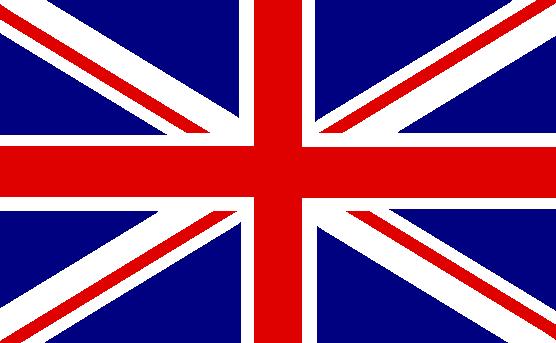 North Ireland North Ireland 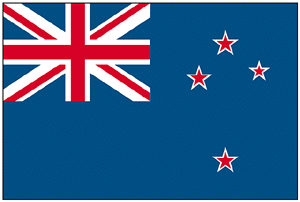 New Zealand New Zealand  Hawaii Hawaii 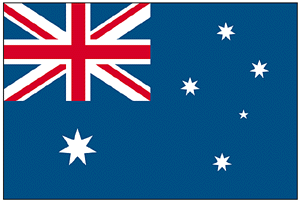 Australia Australia
  USA/Canada USA/Canada  Guam Island Guam Island  Denmark Denmark  Sweden Sweden  France France
 UK UK  Thailand Thailand  Taiwan Taiwan  Iceland Iceland  Finland Finland
 神奈川県条例成立経緯 ( 日本語 ) 神奈川県条例成立経緯 ( 日本語 )
 Kanagawa Pref. Anti-smoke Law: irrevocable injurious negative effect on
the future indoor Kanagawa Pref. Anti-smoke Law: irrevocable injurious negative effect on
the future indoor
clean-air act in Japan.
神奈川県受動喫煙防止条例は将来の喫煙規制に対し深刻な悪影響を及ぼした
 2009年3月執筆 2009年4月加筆 2009年11月加筆 2014年9月加筆 医学博士 宮本順伯 2009年3月執筆 2009年4月加筆 2009年11月加筆 2014年9月加筆 医学博士 宮本順伯
★This Web site is link-free.
This information was provided by the Smokefree Hotel and Travel.
The article was written in March 2009, and last revised in September 2014,
by Junhaku Miyamoto, M.D., PhD.
|